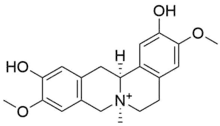Phellodendrine
Phellodendrine is an alkaloid isolated originally from Phellodendron amurense (Rutaceae).[1][2]
 | |
| Names | |
|---|---|
| IUPAC name
2,11-Dihydroxy-3,10-dimethoxyberbin-7α-ium | |
| Systematic IUPAC name
(7S,13aS)-2,11-Dihydroxy-3,10-dimethoxy-7-methyl-5,8,13,13a-tetrahydro-6H-isoquinolino[3,2-a]isoquinolin-7-ium | |
| Identifiers | |
3D model (JSmol) |
|
| ChemSpider | |
PubChem CID |
|
CompTox Dashboard (EPA) |
|
| |
| |
| Properties | |
| C20H24NO4 | |
| Molar mass | 342.4083 g/mol |
| Melting point | 258 °C (496 °F; 531 K) (as iodide) |
Except where otherwise noted, data are given for materials in their standard state (at 25 °C [77 °F], 100 kPa).
Infobox references | |
See also
References
- SHIMAMOTO K, JUJIHARA M, TORII H (March 1962). "[Pharmacological studies on phellodendrine, the quaternary ammonium alkaloid isolated from Phellodendron amurense, a type of Rutaceae.]". Nippon Yakurigaku Zasshi. Folia Pharmacologica Japonica (in Japanese). 58: 138–49. doi:10.1254/fpj.58.138. PMID 13911932.
- Mori H, Fuchigami M, Inoue N, Nagai H, Koda A, Nishioka I, Meguro K (February 1995). "Principle of the bark of Phellodendron amurense to suppress the cellular immune response: effect of phellodendrine on cellular and humoral immune responses". Planta Medica. 61 (1): 45–9. doi:10.1055/s-2006-957997. PMID 7700991.
This article is issued from Wikipedia. The text is licensed under Creative Commons - Attribution - Sharealike. Additional terms may apply for the media files.